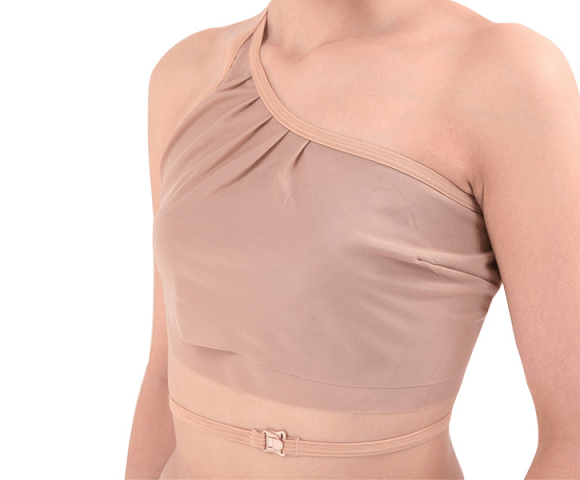
Surgery scar cover is a rare exception to Japan’s traditional no-clothes-in-the-bath rule.
For communal bathing in Japan, whether at a natural onsen hot spring or a piped-in sento public bath, the general rule is that everyone in the tub is supposed to be naked. Stepping into the tub while wearing a bathing suit or wrapped in a towel is believed to sully the purity of the shared water, and Japanese society for the most part holds that nudity in these situations isn’t anything to get embarrassed about (being au naturel is totally natural, after all, when taking a bath).
However, Nagano Prefecture-based apparel company Bright Eyes understands that breast cancer survivors may feel uncomfortably self-conscious going to an onsen if they have mastectomy scars or other visible surgery aftereffects. To help such individuals continue to enjoy Japan’s communal bathing culture, Bright Eyes, whose CEO, Hitomi Kato, is a breast cancer survivor herself, developed a special garment it calls the Bath Time Cover.
The Bath Time Cover, which is available with either a hook or tie to hold it in place across the upper abdomen, looks like a simple one-shoulder undershirt. However, when the wearer removes the rest of her clothes before entering the bathing facility, she leaves the Bath Time Cover on. The garment’s material is specially crafted so that she can wash her body over it and the soap will rinse away with warm water. Even more importantly, the fabric is designed to be have no negative impact on the hygiene or quality of the shared bathwater, with this function confirmed by researchers at Nagano’s Shinshu University and also endorsed by the Japanese federal government’s Ministries of Health, Labor and Welfare, Internal Affairs and Communications, and Land, Infrastructure and Transport.
▼ The Bath Time cover is also quick-drying, so that the wearer can easily towel it off along with her body when exiting the bath before putting the rest of her clothes back on.
Bright Eyes has been selling the Bath Time Cover for close to 20 years, but the garment still remains relatively unknown in Japanese society. A recent tweet from Japanese Twitter user @studio15heart, who spotted an awareness poster for such covers in Mie Prefecture, got plenty of people’s attention, with many commenters saying they’d never heard of them before.
https://twitter.com/a/status/954385348552896512Kato says that initially, Bright Eyes employees themselves went around to hot springs and ryokan inns within Nagano to help spread the word, and have since obtained the cooperation of the Nagano prefectural government in encouraging bath operators to allow the covers’ use through activities such as putting up public awareness posters (for those wishing to confirm if a bath allows them, the Japanese phrase is “Kizuato wo kabaa suru nyuuyokugi wo tsukatte mo ii desu ka?”).
▼ “The hot springs of Shinshu [the traditional name of the Nagano region] welcome the use of bath garments to cover scars” reads the largest text.
Kato says that while there was some initial reluctance from bath operators, these days the garments have won wide acceptance. “Recently, they can be used at most places with no issues,” she says. She encourages those who do encounter resistance to contact Bright Eyes, who will in turn get in touch with the operator and explain the reason for and construction of the garments, which she says is almost always enough to secure happy cooperation.
It should be noted that the use of Bright Eyes’ bath garments is completely user-driven. Japanese hot springs have no standing policies barring bathers who have surgery scars or requiring them to cover them. However, for individuals who make the personal choice to do so, Bright Eyes offers its Bath Time covers for sale directly through its website here, as well as through Amazon here, for 4,104 yen (US$37).
Sources: IT Media, Nagano Prefecture, Togetter, Bright Eyes
Top image: Bright Eyes
Insert images: Bright Eyes, Nagano Prefecture

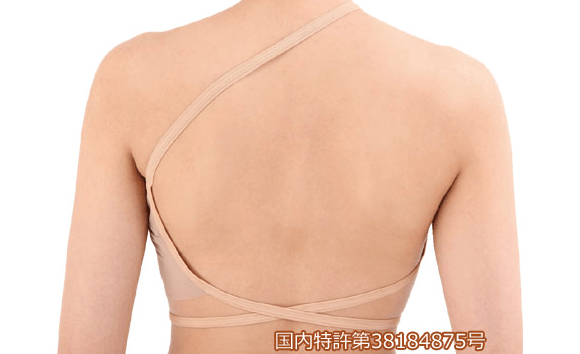
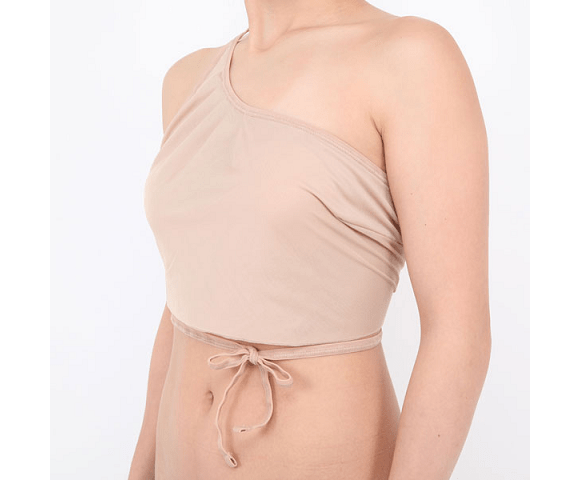
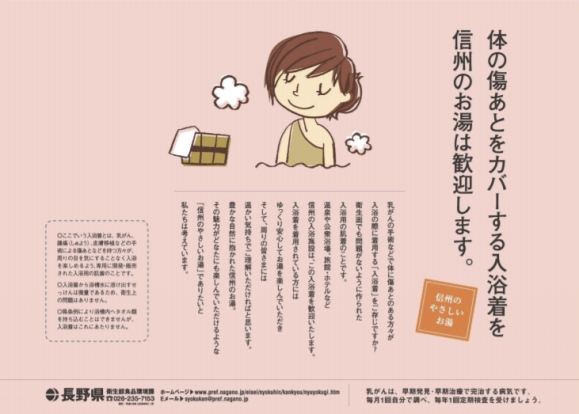
 A private onsen bath with a karaoke machine is two of Japan’s best things with zero embarrassment
A private onsen bath with a karaoke machine is two of Japan’s best things with zero embarrassment Do Japanese women check out each other’s lingerie at the hot springs? Survey investigates
Do Japanese women check out each other’s lingerie at the hot springs? Survey investigates Just how confusing is Japanese onsen culture for a first time visitor?
Just how confusing is Japanese onsen culture for a first time visitor? Japan’s “eternally 17-years-old” anime voice actress offers fans hot spring resort trip with her
Japan’s “eternally 17-years-old” anime voice actress offers fans hot spring resort trip with her Soak in a sand bath in Beppu, Japan’s famous onsen region
Soak in a sand bath in Beppu, Japan’s famous onsen region McDonald’s new Happy Meals offer up cute and practical Sanrio lifestyle goods
McDonald’s new Happy Meals offer up cute and practical Sanrio lifestyle goods All-you-can-drink Starbucks and amazing views part of Tokyo’s new 170 meter-high sky lounge
All-you-can-drink Starbucks and amazing views part of Tokyo’s new 170 meter-high sky lounge More foreign tourists than ever before in history visited Japan last month
More foreign tourists than ever before in history visited Japan last month Starbucks reopens at Shibuya Scramble Crossing with new look and design concept
Starbucks reopens at Shibuya Scramble Crossing with new look and design concept Hamster abandoned at Tokyo ramen restaurant gets new home
Hamster abandoned at Tokyo ramen restaurant gets new home Is the new Shinkansen Train Desk ticket worth it?
Is the new Shinkansen Train Desk ticket worth it? Beautiful Sailor Moon manhole cover coasters being given out for free by Tokyo tourist center
Beautiful Sailor Moon manhole cover coasters being given out for free by Tokyo tourist center Randomly running into a great sushi lunch like this is one of the best things about eating in Tokyo
Randomly running into a great sushi lunch like this is one of the best things about eating in Tokyo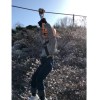 Enjoy viewing Kyoto’s cherry blossoms from above on a guided zipline tour
Enjoy viewing Kyoto’s cherry blossoms from above on a guided zipline tour The oldest tunnel in Japan is believed to be haunted, and strange things happen when we go there
The oldest tunnel in Japan is believed to be haunted, and strange things happen when we go there Disney princesses get official manga makeovers for Manga Princess Cafe opening in Tokyo
Disney princesses get official manga makeovers for Manga Princess Cafe opening in Tokyo We try out “Chan Ramen”, an underground type of ramen popular in the ramen community
We try out “Chan Ramen”, an underground type of ramen popular in the ramen community Beautiful new Final Fantasy T-shirt collection on the way from Uniqlo【Photos】
Beautiful new Final Fantasy T-shirt collection on the way from Uniqlo【Photos】 Foreign English teachers in Japan pick their favorite Japanese-language phrases【Survey】
Foreign English teachers in Japan pick their favorite Japanese-language phrases【Survey】 There’s a park inside Japan where you can also see Japan inside the park
There’s a park inside Japan where you can also see Japan inside the park Japanese convenience store packs a whole bento into an onigiri rice ball
Japanese convenience store packs a whole bento into an onigiri rice ball Studio Ghibli releases Kiki’s Delivery Service chocolate cake pouches in Japan
Studio Ghibli releases Kiki’s Delivery Service chocolate cake pouches in Japan Japan’s bone-breaking and record-breaking roller coaster is permanently shutting down
Japan’s bone-breaking and record-breaking roller coaster is permanently shutting down New definition of “Japanese whiskey” goes into effect to prevent fakes from fooling overseas buyers
New definition of “Japanese whiskey” goes into effect to prevent fakes from fooling overseas buyers Foreign passenger shoves conductor on one of the last full runs for Japan’s Thunderbird train
Foreign passenger shoves conductor on one of the last full runs for Japan’s Thunderbird train Our Japanese reporter visits Costco in the U.S., finds super American and very Japanese things
Our Japanese reporter visits Costco in the U.S., finds super American and very Japanese things Kyoto bans tourists from geisha alleys in Gion, with fines for those who don’t follow rules
Kyoto bans tourists from geisha alleys in Gion, with fines for those who don’t follow rules Studio Ghibli unveils Mother’s Day gift set that captures the love in My Neighbour Totoro
Studio Ghibli unveils Mother’s Day gift set that captures the love in My Neighbour Totoro Domino’s Japan now sells…pizza ears?
Domino’s Japan now sells…pizza ears? New Japanese KitKat flavour stars Sanrio characters, including Hello Kitty
New Japanese KitKat flavour stars Sanrio characters, including Hello Kitty Sales of Japan’s most convenient train ticket/shopping payment cards suspended indefinitely
Sales of Japan’s most convenient train ticket/shopping payment cards suspended indefinitely Sold-out Studio Ghibli desktop humidifiers are back so Totoro can help you through the dry season
Sold-out Studio Ghibli desktop humidifiers are back so Totoro can help you through the dry season Japanese government to make first change to romanization spelling rules since the 1950s
Japanese government to make first change to romanization spelling rules since the 1950s Ghibli founders Toshio Suzuki and Hayao Miyazaki contribute to Japanese whisky Totoro label design
Ghibli founders Toshio Suzuki and Hayao Miyazaki contribute to Japanese whisky Totoro label design Doraemon found buried at sea as scene from 1993 anime becomes real life【Photos】
Doraemon found buried at sea as scene from 1993 anime becomes real life【Photos】 Tokyo’s most famous Starbucks is closed
Tokyo’s most famous Starbucks is closed One Piece characters’ nationalities revealed, but fans have mixed opinions
One Piece characters’ nationalities revealed, but fans have mixed opinions We asked a Uniqlo employee what four things we should buy and their suggestions didn’t disappoint
We asked a Uniqlo employee what four things we should buy and their suggestions didn’t disappoint Princesses, fruits, and blacksmiths: Study reveals the 30 most unusual family names in Japan
Princesses, fruits, and blacksmiths: Study reveals the 30 most unusual family names in Japan Studio Ghibli’s new desktop Howl’s Moving Castle will take your stationery on an adventure
Studio Ghibli’s new desktop Howl’s Moving Castle will take your stationery on an adventure Onsen in Nagano will now welcome foreigners with tattoos, as long as they patch ’em up
Onsen in Nagano will now welcome foreigners with tattoos, as long as they patch ’em up Japanese government encouraging hot springs to ease tattoo restrictions
Japanese government encouraging hot springs to ease tattoo restrictions Bathing with Pokémon? Healing species’ powers tapped for Pokémon Recovery public baths in Japan
Bathing with Pokémon? Healing species’ powers tapped for Pokémon Recovery public baths in Japan Free literal forest bathing in Hokkaido is a hot spring experience you’ll never forget【Photos】
Free literal forest bathing in Hokkaido is a hot spring experience you’ll never forget【Photos】 A whole bunch of capybara videos to help ease your presidential election stress【Videos】
A whole bunch of capybara videos to help ease your presidential election stress【Videos】 Rub-a-dub-dub and relax in a tub: Survey reveals wintertime bathing habits across Japan
Rub-a-dub-dub and relax in a tub: Survey reveals wintertime bathing habits across Japan Nara hotel with hot spring baths by imperial palace site is a reason to remember the prefecture
Nara hotel with hot spring baths by imperial palace site is a reason to remember the prefecture Naked Japanese bathtub drifting 【Video】
Naked Japanese bathtub drifting 【Video】 The 10 best hotel hot springs in Japan, as chosen by Japanese travelers
The 10 best hotel hot springs in Japan, as chosen by Japanese travelers Our Japanese reporter visits Czechia’s famous beer spas and boozily bathes in a bath of beer
Our Japanese reporter visits Czechia’s famous beer spas and boozily bathes in a bath of beer Famous hot springs of Beppu now offering portable inflatable onsen with authentic Beppu water
Famous hot springs of Beppu now offering portable inflatable onsen with authentic Beppu water Ridiculously powerful hot spring bath in Japan earns both our respect and our fear【Videos】
Ridiculously powerful hot spring bath in Japan earns both our respect and our fear【Videos】 Capybaras celebrate winter in luxurious mikan bath【Photos】
Capybaras celebrate winter in luxurious mikan bath【Photos】 Beautiful new Tokyo hotel gives you the best of both worlds with hot spring bath in the big city
Beautiful new Tokyo hotel gives you the best of both worlds with hot spring bath in the big city You can make your own hot spring bath at this river in central Japan【Japan travel】
You can make your own hot spring bath at this river in central Japan【Japan travel】 Ibaraki Prefecture promotes onsen hot springs with muscly man bathing in 4K【Videos】
Ibaraki Prefecture promotes onsen hot springs with muscly man bathing in 4K【Videos】
Leave a Reply